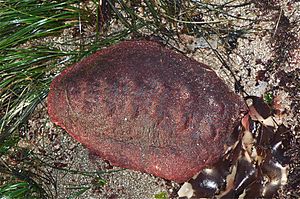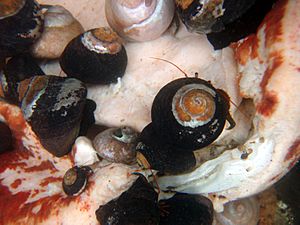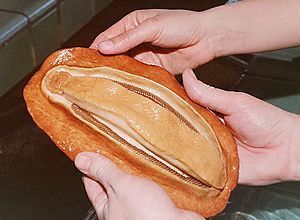Gumboot chiton facts for kids
Quick facts for kids Gumboot chiton |
|
|---|---|
 |
|
| Scientific classification | |
| Genus: |
Cryptochiton
|
| Species: |
stelleri
|
| Synonyms | |
|
|
The gumboot chiton (Cryptochiton stelleri), also called the giant western fiery chiton, is the biggest type of chiton. It can grow up to 36 cm (about 14 inches) long and weigh more than 2 kg (over 4 pounds)! You can find it along the northern Pacific Ocean coasts, from Central California all the way to Alaska, across the Aleutian Islands, and down to Japan. It lives in rocky areas where the tide goes out (the lower intertidal zone) and just below the water's surface (the subtidal zone).
Some people who explore tide pools jokingly call this chiton the "wandering meatloaf" because of its shape. The name "gumboot chiton" probably comes from how it looks like a part of a rubber Wellington boot, which are sometimes called "gum rubber" boots.
Chitons are a type of mollusc (like snails or clams). They usually have eight hard, armored plates called valves that run down their back in a flexible line. But the gumboot chiton is special! Its plates are completely hidden by its tough, leathery upper skin, which is called a girdle. This girdle is usually reddish-brown or brown, but sometimes it can be orange.
Chitons have many tiny teeth that are partly made of a very hard material called magnetite. This makes their teeth strong enough to scrape algae off rocks. The parts holding their teeth also contain a rare mineral called santabarbaraite. The gumboot chiton was the first living thing found to use this material, which was only discovered in Italy in the year 2000!
What's in a Name?
The scientific name for the gumboot chiton is Cryptochiton stelleri. This Latin name means Steller's hidden chiton. The "Steller" part honors Georg Wilhelm Steller, a German zoologist from the 1700s. He was the first person to describe many different animals and plants found along the northern Pacific seashore.
The word "hidden" or "concealed" in its name refers to a special feature of this chiton. Unlike most chitons, its eight shell plates are not visible. They are completely covered by the gumboot's thick, leathery girdle. Many chiton names are based on how their plates look, so it's very likely that the "hidden" part of its name points to these plates being completely out of sight.
Life Cycle and Habits
The underside of a gumboot chiton is usually orange or yellow. Most of this underside is taken up by a large, muscular foot, similar to what you'd see on a snail or slug. Its gills are found in special grooves along the outer edge of this foot.
Gumboot chitons usually cling tightly to rocks. They move very slowly as they search for their main food: algae. They scrape the algae off rocks using a special tongue-like organ called a radula. This radula is covered with rows of teeth tipped with magnetite, making them very strong. They also eat other ocean plants like sea lettuce and giant kelp.
The gumboot chiton is a nocturnal creature, meaning it mostly feeds at night. During the day, it often stays hidden. However, on foggy days, you might spot one out in a tide pool or on exposed rocks.
These amazing creatures can live for a very long time, sometimes more than 40 years! Interestingly, other small animals sometimes live within the gumboot chiton's gills. This relationship is called commensal, which means one animal benefits, but the chiton isn't harmed or helped. For example, a pale yellow scale worm called Arctonoe vittata (which can grow up to 10 cm long) has been found living in more than a quarter of gumboot chitons studied. Sometimes, a small crab called Opisthopus transversus can also be found there.
The gumboot chiton's bony armoring plates are sometimes called "butterfly shells" because of their shape. You might find these plates, or even whole chitons, washed up on beaches. This is because gumboot chitons don't hold onto rocks as tightly as most other chitons do. So, strong waves can sometimes knock them loose from their homes.
Predators

The gumboot chiton has only a few natural enemies. The most common one is a snail called the lurid rocksnail. This small snail usually only manages to eat the outer skin of the chiton. While some people say the lurid rocksnail is its only predator, others list animals like the sea star Pisaster ochraceus, some types of octopus, and the sea otter as predators of the gumboot chiton.
Human Food
People have eaten the gumboot chiton before. Native Americans and early Russian settlers in Southeast Alaska used it as a food source. However, most people don't find it very tasty. Its texture is often described as extremely tough and rubbery.
One old book about Pacific Ocean animals described trying to cook a gumboot chiton. The writers said they would only eat it if they were starving! They could only get one thin, tough piece of "steak" from a large chiton, and it smelled so strongly of fish that they threw it away before even frying it.


